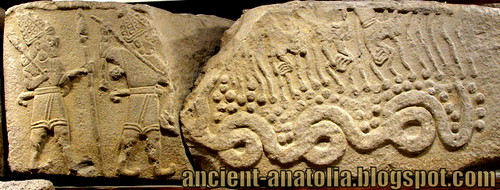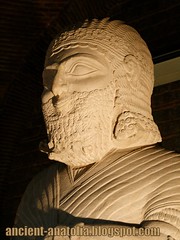
 In Hittite mythology, Illuyanka was a serpentine dragon slain by Tarhunt, the Hittite incarnation of the Hurrian god of sky and storm. It is known from Hittite cuneiform tablets found at Çorum-Boğazköy, the former Hittite capital Hattusa. The context is a ritual of the Hattian spring festival of Puruli.
In Hittite mythology, Illuyanka was a serpentine dragon slain by Tarhunt, the Hittite incarnation of the Hurrian god of sky and storm. It is known from Hittite cuneiform tablets found at Çorum-Boğazköy, the former Hittite capital Hattusa. The context is a ritual of the Hattian spring festival of Puruli.The myth is found in Catalogue des Textes Hittites 321. It is indeed preserved only in Hittite language, but since the names of the characters are Hattic especially, it is considered Hattic myth. It survives in two versions. This myth shows strong resemblance to the ancient myth of Typhon.
In the first version, the two gods fight and Illuyanka wins. Teshub then goes to the Hattian goddess Inaras for advice. Having promised her love to a mortal named Hupasiyas in return for his help, she devises a trap for the dragon. She goes to him with large quantities of food and drink, and entices him to drink his fill. Once drunk, the dragon is bound by Hupasiyas with a rope. Then the Sky God Teshub appears with the other gods and kills the dragon.
"Thusly Mr. Killa, the Anointed Priest of the Storm God of Nerik, (concerning) the matter of the purulli-festival [of] the Storm God of Heaven, when they speak thusly -In the second version, after the two gods fight and Teshub loses, Illuyanka takes Teshub's eyes and heart. To avenge himself upon the dragon, the Sky God Teshub marries the goddess Hebat, daughter of a mortal, named Arm. They have a son, Sarruma, who grows up and marries the daughter of the dragon Illuyanka. The Sky God Teshub tells his son to ask for the return of Teshub's eyes and heart as a wedding gift, and he does so. His eyes and heart restored, Teshub goes to face the dragon Illuyanka once more. At the point of vanquishing the dragon, Sarruma finds out about the battle and realizes that he had been used for this purpose. He demands that his father take his life along with Illuyanka's, and so Teshub kills them both with thundery rain and lightning. This version is illustrated on a relief which was discovered at Malatya (dating from 1050-850 BC) and is on display in the Museum of Anatolian Civilizations in Ankara, Turkey.
"May the land grow and thrive! May the land be protected!" When it grows and thrives, they perform the festival of the purulli.
When the Storm God and the serpent fought each other in the city of Kiškilušša, the serpent vanquished the Storm God.
So the Storm God implored all of the gods, "Come together!" And Inara prepared a feast.
She prepared everything in great quantity: a large vessel of wine, a large vessel of marnuwanda-beer, a large vessel of walḫi-beverage. In the vessels she made abundance.
Inara went to the city of Ziggaratta, and she found Mr. Ḫupašiya, a mortal.
Thusly Inara to Ḫupašiya, "I am about to do such-and-such a thing! You, join with me!"
Thusly Ḫupašiya to Inara, "If I may sleep with you, then I will come (and) I will do that of your heart." So he slept with her.
Inara led Ḫupašiya away and she concealed him. Inara dressed herself up, and she invited the serpent up from its lair (lit. "hole") (saying), "I am about to make a feast! Come eat and drink!"
So the serpent came up along with his sons and they ate and drank. They drank every vessel and they made themselves drunk.
They did not want to go down into the lair again. Ḫupašiya came and tied up the serpent with rope.
The Storm God came and killed the serpent. The gods were with him.
Inara built a house on a rock for herself in the land Tarukka. She set Ḫupašiya in the house. Inara repeatedly commanded him, "When I go into the countryside, you must not look out from the window! If you look out, you will see your wife and your children!"
When 20 days passed, he looked out from the window, and he saw his wife and his children.
When Inara came back from the countryside, he began to weep, "Let me back home!"
Thusly Inara to Ḫupašiya, "Why did you look out? [. . .]" [. . .]
12 by means of a crime [. . .]
13 Of? the Storm God [. . .] the meadow [. . .]
14 he [. . .] and him [. . .]
Inara [went?] to the city Kiškilušša. When she put [. .] her? house and the underground spring? [into] the hand of the king [. . .] Because (of this) we are celebrating the first purulli-festival. The hand [of the king will hold? the house?] of Inara and the underground spring?.
Mt. Zaliyanu is first of all (the gods). When he assigned rain in Nerik, the staff-bearer brings the thick bread from Nerik.
He asked Mt. Zaliyanu for rain, and he brings it to him [on account of] the bread.
27 And he [. . .]
28 And it to him [. . .] he [. . .]
29 And he/them [. . .]
30 [. . .]
(Gap)
This [. . .]
What Kella the Anointed priest said: [First], the serpent vanquished the Storm God, and he took [(his) heart and (his) eyes]. And [the Storm God feared?] him.
He took the daughter of a poor man for his wife, and he begat a son. When he grew up, he took for himself the daughter of the serpent in matrimony.
The Storm God repeatedly instructed (his) son, "When you enter the house of your wife, request from them (my) heart and (my) eyes!"
When he went, he requested the heart from them, and they gave it to him. Later, he requested the eyes from them, and those, too, they gave to him. He brought them to the Storm God, his father. The Storm God took back the heart and the eyes.
When his form was again sound in its former state, he again went to the sea for battle. When he gave battle to him, he ultimately began to vanquish the serpent, and the son of the Storm God was with the serpent. He cried up to heaven, to his father:
"Take me together (with them)! Do not spare me!" So the Storm God killed the serpent and his son. That Storm God is about to/just finished [. . .]
Thusly Kella, the Anointed Priest of the Storm God of Nerik: When the gods [. . .]
1 [. . .]
2 [. .] they [. . .] and for him food [. . .]
3 [. . .] back to Nerik [. . .]
4 [. . .] Let!
5 The god Zašḫapuna (acc.)
6 [. . .] (s)he did [. . .] and the Storm God of Nerik
7 [. . .] they went. The god Zaliyanu[. . .]
8 [. . .] (s)he went back [. . .]
9 [. . .] (s)he? gave? [. . .]
10 [. . .] to? Nerik [. . .]
11 [. . .] the serpent? [. . .]
For the Anointed Priest they made the first (ranked) gods into the last, and they made the last (ranked) into the first (ranked) gods.
The cult revenues of the god Zaliyanu are great. Zašḫapuna, wife of Zalinui (i.e. Zaliyanu), is greater than the Storm God of Nerik.
Thusly the gods, to the Anointed Priest - the taḫpurili-man: "When we go to Nerik, where will we sit down?
Thusly the Anointed Priest, the taḫpurili-man: "When you sit on a basalt throne, and when the Anointed Priests! cast the lots, then the Anointed priest who holds (the idol of) the god Zalinu (i.e. Zaliyanu) - A basalt? throne is placed over the water, and he sits there."
All the gods will stand together, and they will cast the lots, and of all the gods of the city Kaštama, Zašḫapuna will be the greatest.
Because she is the wife of Zalinui, and the goddess Tazzuwaši is the concubine, these three men will remain in the city Tanipiya.
Afterwards, in the city Tanipiya, the field and fallow are given forth from the king.
6 kapunu-measures of field, 1 kapunu-measure of vineyard, a house and a threshing place, 3 houses for the household personnel - it exists on a tablet. For me there is fearful respect of the word. I said these things!" Beckman, Gary, "The Anatolian Myth of Illuyanka"
The Hittite texts were introduced in 1930 by W. Porzig, who first made the comparison of Teshub's battle with Illuyankas with the sky-god Zeus' battle with serpent-like Typhon, told in Pseudo-Apollodorus, Bibliotheke (I.6.3); the Hittite-Greek parallels found few adherents at the time, the Hittite myth of the castration of the god of heaven by Kumarbi, with its clearer parallels to Greek myth, not having yet been deciphered and edited.

Shahmaran Cult
Shahmaran is a mythical creature usually said in southern, central and eastern Anatolia, Iran and Iraq. The name of Shahmaran comes from words "Shah" and "Maran". "Shah" means King/Queen and "Maran" means snake in Persian. In the tale, Shahmaran is defined as a wise and benign woman. She is the queen of snakes. She has the features of a woman above the waist and those of a sepent below the waist. When she died, her spirit is believed to pass to her daughter.
In Turkey, Shahmaran is believed to live in the Mediterranean town of Tarsus. A legend passes the same name in the Mardin region. In this region she is depicted with famous Shahmaran pictures.
